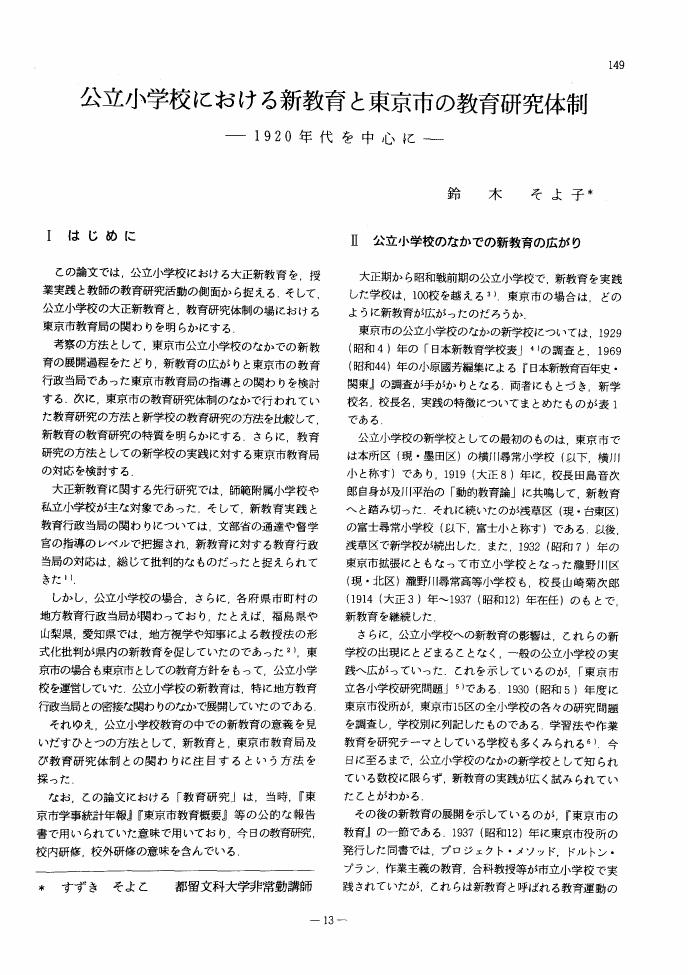2 0 0 0 OA 公立小学校における大正新教育についての研究ノート (松井春満教授定年退官記念号)
- 著者
- 鈴木 そよ子
- 出版者
- 奈良女子大学
- 雑誌
- 奈良女子大学教育学科年報 (ISSN:09183604)
- 巻号頁・発行日
- vol.12, pp.125-136, 1995-12
During the 1920s, many Japanese elementary school teachers tried new methods of teaching. There were several innovative approaches in public schools, private schools and attached schools. I knew New Education when I was at Nara Women's University. I grew up in Ehime Prefecture. When I was a high school student, I thought the school curriculum was not integrated. In order to understand the world and in order to find how to live, what kind of curriculum can we make? I have thought this matter during my student life. I had the idea, listening to the lectures about New Education. The teachers who practiced New Education, tried to construct school curriculums according to their practices. I collect the characteristics of New Education in public schools. (1)In the lessons, writing, making, discussing, describing, observating were important. Teachers used these as teaching materials. (2)Teachers started from what they tried to study. Composition and Mathematics in the children lives, making, and so on. (3)Teachers studied to make some groups according to the themes. (4)The principals were leaders of educational practices in the schools of New Education. And the City School Inspectors evaluated the methods of study in innovative schools positively as a way of improving education. (5)New Education declined not because the practices had many problems but because members of the teachers changed. (6)Teachers can make creative educational activities when they can construct the lessons according to their own teaching materials. These characteristics show, in order to educate children, teachers need free feelings, spirits and the sense of fulfillment. I think a good curriculum creates teacher's and children's sense of fulfillment and human dignity.
1 0 0 0 OA R.シュタイナーの子ども観 -発達と気質の側面から-
- 著者
- 鈴木 そよ子
- 雑誌
- 国際経営フォーラム (ISSN:09158235)
- 巻号頁・発行日
- no.29, pp.121-140, 2018-12-25
自由ヴァルドルフ学校は、1919年にドイツのシュトゥットガルトにおいて設立された。2017年現在では、1092校を数える。本稿では、ヴァルドルフ学校の指導者ルドルフ・シュタイナーの子ども観のうち、発達の段階と課題、そして、気質の観点からそれぞれの特徴と働きかけ方について考察する。 シュタイナーは、子どもの発達段階を3期に分けて捉えている。 第一期:誕生から歯の生え替わる時期まで(およそ0 ~ 7歳) 第二期:歯の生え替わる時期から性的成熟期まで(およそ7 ~ 14歳) 第三期:性的成熟期以降(およそ14~ 21歳) シュタイナーの発達観によれば、第一期には想像力を豊かにすること、第二期には訓練された想像力の基盤に立って、感情・意志などの心的諸力を豊かにすることが十分なされて初めて、第三期に入ったのち、悟性概念を用いた的確な思考・判断が可能になるのである。 また、シュタイナーは、気質学の観点から子どもを把握するが、多血質、憂鬱質、粘液質、胆汁質の四気質が個々の性格を構成していると捉える。教師に求められた、子ども理解及び子どもへの働きかけ方は3点にまとめられる。 第一点は、四気質の特徴を把握すること。 第二点は、教師自身が子どもの中で、優位を占めている気質を受け入れることによって、気質の短所を長所に変えていくこと。第三点は、教師自身の働きかけと並行して、子どもたち同士の影響力・同化力を十分に活かすためのグループ作りを工夫すること。
1 0 0 0 OA 公立小学校における新教育と東京市の教育研究体制1920年代を中心に
- 著者
- 鈴木 そよ子
- 出版者
- 一般社団法人 日本教育学会
- 雑誌
- 教育学研究 (ISSN:03873161)
- 巻号頁・発行日
- vol.57, no.2, pp.149-158, 1990-06-30 (Released:2009-01-13)
- 参考文献数
- 36

